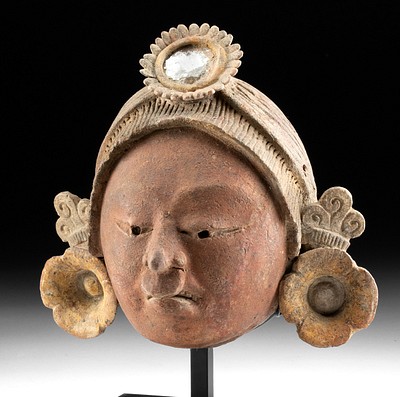Signed Tiffany Favrile Glass Floriform, ex-Butterfield
Lot 171
About Seller
Artemis Gallery
686 S Taylor Ave, Ste 106
Louisville, CO 80027
United States
Selling antiquities, ancient and ethnographic art online since 1993, Artemis Gallery specializes in Classical Antiquities (Egyptian, Greek, Roman, Near Eastern), Asian, Pre-Columbian, African / Tribal / Oceanographic art. Our extensive inventory includes pottery, stone, metal, wood, glass and textil...Read more
Categories
Estimate:
$4,000 - $8,000
Absentee vs Live bid
Two ways to bid:
- Leave a max absentee bid and the platform will bid on your behalf up to your maximum bid during the live auction.
- Bid live during the auction and your bids will be submitted real-time to the auctioneer.
Bid Increments
| Price | Bid Increment |
|---|---|
| $0 | $25 |
| $300 | $50 |
| $1,000 | $100 |
| $2,000 | $250 |
| $5,000 | $500 |
| $10,000 | $1,000 |
| $20,000 | $2,500 |
| $50,000 | $5,000 |
| $100,000 | $10,000 |
| $200,000 | $20,000 |
About Auction
By Artemis Gallery
Jul 14, 2022
Set Reminder
2022-07-14 10:00:00
2022-07-14 10:00:00
America/New_York
Bidsquare
Bidsquare : Exceptional Antiquities Ethnographica Fine Art
https://www.bidsquare.com/auctions/artemis-gallery/exceptional-antiquities-ethnographica-fine-art-9692
Museum-worthy examples of classical antiquities (Egyptian, Greek, Roman, Near Eastern), Viking, Far East / Asian, Pre-Columbian, African / Tribal, Oceanic, Native American, Spanish Colonial, Fossils, Ancient Jewelry, Fine / Visual Arts, so much more! Artemis Gallery info@artemisgallery.com
Museum-worthy examples of classical antiquities (Egyptian, Greek, Roman, Near Eastern), Viking, Far East / Asian, Pre-Columbian, African / Tribal, Oceanic, Native American, Spanish Colonial, Fossils, Ancient Jewelry, Fine / Visual Arts, so much more! Artemis Gallery info@artemisgallery.com
- Lot Description
Louis Comfort Tiffany (American, 1848-1933). Gold Favrile Floriform Vase, ca. 1900. Signed and numbered "L.C. Tiffany - Favrile 692 D" in counterclockwise direction on underside of base. An exquisite Gold Favrile Glass flower-shaped vessel comprised of a ribbed foot leading to a long, slender stem with a single nodule at its center, a ribbed cup, and a multi-folded rim. The shimmering gold favrile glass presents with multi-color iridescence in shades of fuchsia, violet, and citrine. Simply stunning and signed on the foot! Size: 10.625" H (27 cm)
According to Paul Doros' catalogue note, "Blown Favrile glass vases in the shape of flowers were among the earliest distinctive forms produced by the glasshouse founded by Louis Tiffany in 1893. His love of flowers, as well as Arthur Nash’s familiarity with similar vases being made at the time in his native England, were likely the major contributing factors. Under their guidance, Thomas Manderson, one of the company’s gaffers, developed the initial flowerforms and examples were displayed at the Tiffany Glass and Decorating Company’s first major exhibition of blown glass in 1894. The initial attempts were ungainly, with thick, sometimes curved, stems supporting narrow bowls of swirled opaque glass. Within a year of their first appearance, however, flowerforms were at the forefront of a grouping described as 'delightful in their simplicity, yet it is a graceful simplicity….They are the ever beautiful primaries of artistic shape.'" (Paul E. Doros "The Art Glass of Louis Comfort Tiffany" Vendome Press, 2013)
According to the Cooper Hewitt Museum's description of a similar flower form vase, "Louis Comfort Tiffany, son of Tiffany & Co. founder, was fascinated by color, nature, and the decorative arts and design of foreign and ancient cultures. He studied the lavish collections of Edward C. Moore, Tiffany & Co.'s head of design, and traveled throughout Europe and East Asia. He became enamored with ancient glass that had been buried for centuries and turned iridescent from decay, and strove to reproduce these effects for modern collectors. In his experiments working with professional glassmakers and chemists, Tiffany developed what he dubbed favrile glass (based on the Old English term fabrile, or handmade), which he patented in 1894. In Favrile glass, the decayed effect is transformed into shimmering colors with inventive patterns and unique shapes—often inspired by nature, as seen in this flower-form vase. The decoration, rather than being etched or engraved after the glass is blown and fired, is created with color while the glass is molten. Tiffany prized the impurities in form and color that resulted from such delicate work, and became famous for these striking wares."
Provenance: ex-Nancy and Dr. E.F. Simpson collection, Los Angeles, California, USA, acquired from 1970 to 2000
All items legal to buy/sell under U.S. Statute covering cultural patrimony Code 2600, CHAPTER 14, and are guaranteed to be as described or your money back.
A Certificate of Authenticity will accompany all winning bids.
PLEASE NOTE: Due to recent increases of shipments being seized by Australian & German customs (even for items with pre-UNESCO provenance), we will no longer ship most antiquities and ancient Chinese art to Australia & Germany. For categories of items that are acceptable to ship to Australia or Germany, please contact us directly or work with your local customs brokerage firm.
Display stands not described as included/custom in the item description are for photography purposes only and will not be included with the item upon shipping.
#172259Signed and numbered "L.C. Tiffany - Favrile 692 D" in counterclockwise direction on underside of base. Areas of surface wear as shown. Tiny internal bubble on cup. Old Butterfield & Butterfield tag.Condition
- Shipping Info
-
All shipping is handled in-house for your convenience. Your invoice from Artemis Gallery will include shipping calculation instructions. If in doubt, please inquire BEFORE bidding for estimated shipping costs for individual items.
-
- Buyer's Premium



 EUR
EUR CAD
CAD AUD
AUD GBP
GBP MXN
MXN HKD
HKD CNY
CNY MYR
MYR SEK
SEK SGD
SGD CHF
CHF THB
THB















